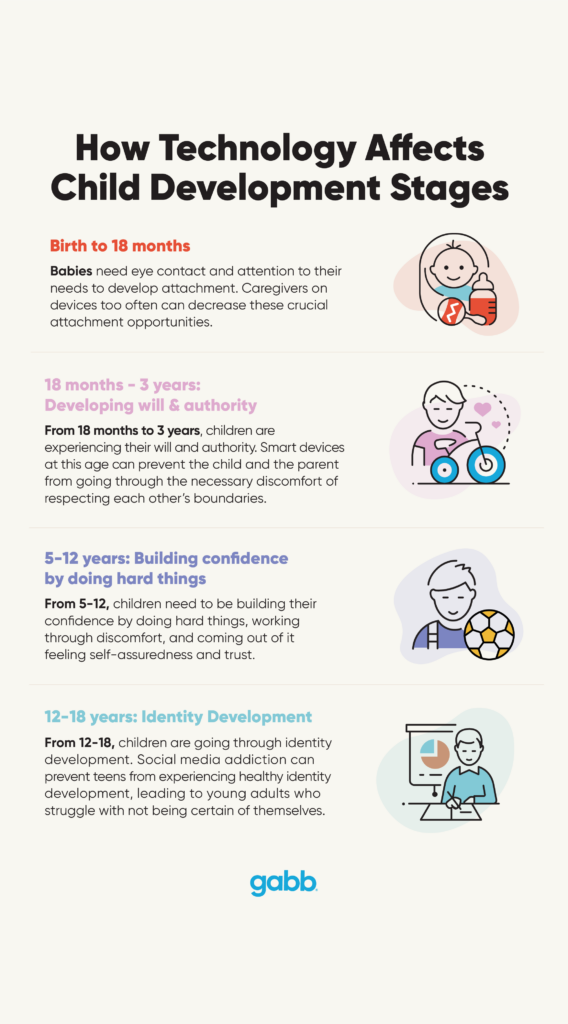After twenty years of research on how technology affects children’s development, you’d think nothing would shock me.
But when I heard Leslie Weirich’s story about her 14-year-old son Austin, I was shocked.
I first met Leslie on LinkedIn where she talked candidly about her son’s early smartphone usage. She is often asked what she would do differently to change the outcome of her son taking his life.
Her answer? She would not have given him a smartphone so early.
Austin was 14 when he began engaging in interpersonal relationships in an online culture. She’s convinced that Austin having a smartphone before he was ready was a major factor in his death by suicide.
I found Leslie’s willingness to speak about something unpopular and her courage to face criticism to be refreshing. Leslie’s story is tragically becoming more common in today’s digitally addicted culture.
Too Much Tech, Too Soon
Social media is hindering natural developmental processes. The reality is many of today’s children are younger than 14 when they receive their first smart device.
A Pew Research study found that most parents (73%) believe children are only ready for their own smartphone after the age of 12 but nearly half (45%) said that having a smartphone between the ages of 12-14 is acceptable.
Research also shows a growing number of children as young as 2 are using tablets and smart devices. According to additional Pew Research in 2020, 35% of children 0-2 are using tablets and 49% of children in this age range are using smart devices.
Parents may not realize the early use of smart devices wires the brain for addiction and prevents child development. Parenting is hard. It can certainly be tempting to use screens to entertain an active child when you need them to be calm, or to help them regulate if they are having a tantrum.
As difficult as it can be, an understanding of basic child developmental stages makes it clear that it’s worth the effort to delay early usage of technology. Parents can do their best to delay early usage of technology to allow for proper physical, cognitive, and social/emotional development.
Child Development Stages
Children go through phases, or stages, of development from a social/emotional, cognitive, and physical standpoint. 90% of cognitive (brain) development occurs before the age of six. The remaining 10% takes place in the prefrontal lobe of the brain — responsible for executive functioning, impulse control, and decision making — and doesn’t fully develop until the age of 25.
Children need to go through said stages of development naturally, with each stage building on the one before it.
Birth to 18 months: Attachment
From birth to 18 months, babies are in the attachment phase. Babies cue their caregivers, usually through crying, when they have a need. It is important the caregiver responds to that need. If the need is met, the baby will develop trust and connection.
Babies need human interaction in the form of eye contact, positive facial expressions, and physical touch.
In the “Still Face Experiment,” Dr. Edward Tronick demonstrates a baby’s distress upon the mother having a still face and not interacting with her baby. In the beginning of the study the mother is cooing, smiling, and playing with her baby.


Then the mother’s face becomes still and the baby tries to get her attention through more smiling and cooing. However, when the mother’s face continues to be still the baby becomes distressed and begins to scream and eventually cry. Then the mother begins interacting again and the baby calms.
In today’s terms, the still face can manifest in either the mother having a device between her and the baby or the baby having a device themselves. Devices in this stage of development prohibit a connection between baby and caregiver and can lead to a lack of attachment and trust.
Also, during this time babies’ movement is very important. Developmental milestones such as crawling are crucial to developing the neural pathways of the brain.
Smart devices can get in the way of babies’ movement by distracting and entertaining them so they don’t attempt to crawl. Crawling is hard work, and if there is a screen in the way babies will be mesmerized by that and not attempt to move. Movement is necessary for social/emotional development, which then supports brain development.
18 months – 3 years: Developing will & authority
From 18 months to 3 years children are experiencing their will and authority. Children need to have boundaries and learn to respect their parents’ boundaries.
This stage is a delicate balance of both, so the child can feel safe to explore their will but also respect the parent’s “no.” If attachment went well, this stage is easier to master because trust has been established.
This is the foundation for boundaries and sets them up in life to have their own and respect others’ boundaries in relationships outside the family later on. This is a very uncomfortable stage at times for both children and parents because striking this balance is often hard. This is why this stage of development has been dubbed “the terrible 2s.”
As previously stated, many children in this age range are using smart devices. The use of smart devices brings children and parents peace and solace from the difficult nature of learning boundaries. While it seems benign to play educational games at this age, the use of a smart device can prevent the child and the parent from going through the necessary discomfort of respecting each other’s “no.”
3-5 years: Developing independence and autonomy
From the ages of 3 to 5 children are learning how to be autonomous and independent. If they do things that are difficult on their own, they build tolerance for going out into the world without their parents.
Examples of this are tying their shoes, getting themselves dressed, buckling their seat belts, and learning how to wash themselves and brush their teeth on their own. These are difficult tasks at this age because they require fine motor skills that are still developing (for example, the bones in their hands don’t fully fuse together until around the age of six).
Emotionally, they need to learn how to work through hard things at this age. It’s important they learn and practice to build their frustration tolerance for tasks that they may not be successful doing right away.
Due to these tasks being frustrating, many children and parents avoid learning in order to make things easier and parents end up doing developmental tasks for their children. A good way to teach a new developmental skill is to show them/model the activity first, then support them doing it on their own. This adds to building trust in themselves that they can do it without the parent.
If children are on tablets and smartphones during this time in development, they are allowed to avoid frustrating feelings that come from engaging in developmental tasks. They are avoiding this by getting a surge of dopamine from the device. This impedes on the developmental process of learning how to work through hard things and build frustration tolerance.
Children can learn to trust themselves through being allowed to do hard things. If children of this age do not trust themselves, they can develop separation anxiety and social/emotional deficits. If they can trust themselves, they have more confidence to interact and engage with other children and adults outside their family and this can foster social/emotional growth.
5-12 years: Building confidence by doing hard things
From 5 to 12 children need to be building their confidence. Confidence is born out of doing hard things, working through discomfort, and coming out of it feeling self-assuredness and trust. Adults who understand this allow children to experience discomfort.
If the prior stages went well, they will have trust in others, trust in their boundaries, respect for others’ boundaries, and feel capable and strong. This makes it much more likely they will build confidence.
In some families, this age range is when children shift from using their parents’ devices to receiving their own smart device. This often stems from practical reasons, such as staying in touch as children have more separation from their parents as they get older. Exposure to such things as social media and group texting often increase as a result.
Many children today are avoiding growing pains and confidence building due to smart device usage. Smart devices can be a disruption to a child learning how to build their confidence because when a device is present, there is an emotional disconnect from the real world. Smart devices are addictive in the way that they allow for comfort and good feelings all the time while present.
Childhood is hard and comes with growing pains that are necessary and lead to maturity.
12-18 years: Identity Development
From 12 to 18 children are going through identity development. This is a time when they begin to individuate and separate from their parents more. They are learning all about who they are, building their character traits, and becoming who they will be.
If all went well prior to this stage, identity development — while very uncomfortable and difficult initially — will lead to strong, independent, self-assured young adults.
Teens in this age range report using technology 7-8 hours per day, with many of them (45%) admitting to using it “almost constantly.”
If children weren’t on social media before this age, they likely are now — 54% of teens say it would be hard to give up social media. Social media addiction is rampant among today’s youth and it is preventing children from experiencing identity development the way they need to. This has led to a generation (Gen Z) of young adults who struggle with not being certain in themselves.

The Root of Social Media Addiction
The addiction to social media is rooted in the pursuit of peer validation and connection. It’s particularly addicting during the identity phase of development because teens are insecure in themselves, and many of them have unresolved issues from the confidence-building stage.
Teenagers are essentially addicted to each other — an interconnected web of mirror images seeking acceptance and love. In their digital personas, they can craft identities that cater to the approval of their peers. This virtual existence becomes a conduit for an imaginary audience, enabling them to be anyone they desire. This generation of children often mistake the feelings of euphoria they get from interacting online as feelings of love. It feels so real to them.
In my 20 years of practice, I’ve seen many children of today’s generation avoid their feelings of insecurity and discomfort like the plague. Avoidance of feelings is not new but is more common in this generation due to technology and the culture of parenting.
I coach parents to help their children experience difficult feelings. Many parents are uncomfortable with their children’s discomfort, rendering them helpless to engage in necessary developmental tasks. Smart devices also allow for this avoidance, creating a perfect storm. Children today may not be building resiliency because the combination of parenting and the effects of technology make life comfortable for them.

What Parents Can Do
If Pandora’s box is already open and you’ve given your child a screen too soon, the negative effects can be undone. It’s called repair. Eliminating a smart device recalibrates the nervous system quickly, and parents can work on connecting to their children.
Parents of younger children can delay and reduce screen time as much as possible to allow a child healthy development. Caregivers can develop a family culture where emotions are heard and kids are given opportunities to develop confidence through doing difficult things.
It is up to us as parents to help our children ride the wave of emotion that is life and childhood. All of the feelings are important — even the uncomfortable ones — because out of the darkness comes the light, and we can’t have one without the other. That means parents have to allow for their own discomfort and difficult feelings, so they can hold the space for their children’s feelings.
Parents can teach kids to handle difficult feelings by modeling how to regulate their own feelings. This is called “co-regulation.” Parents can receive support on how to regulate their emotions through caring for themselves, consulting with parent coaches, and in some cases, psychotherapy.
How do you show your children that difficult feelings are important? Let us know in the comments.










Success!
Your comment has been submitted for review! We will notify you when it has been approved and posted!
Thank you!